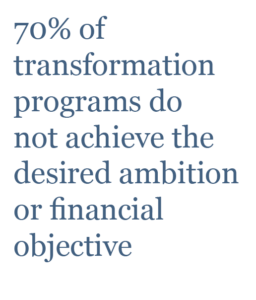Unlocking Value Creation:
A Guide for Middle Market Founders
By Matt Gilbreath, Managing Director | October 2023
Twenty-five years ago, Harvard Business Review identified eight reasons transformations fail. McKinsey and Company have added their own experience and research over time, putting forward several pitfalls for change initiatives that don’t quite hit the mark. One of their long-standing insights and the real burning-platform: around 70% of transformation programs do not achieve the desired ambition or financial objective.
While these studies are robust (and do suggest a very strong checklist for success), the subjects of the conversation are publicly traded, often Fortune-100, typically multi-national companies. So, it begs the question: what of these transformation watch-outs apply to middle-market, founder-led, private companies? Is there a formula for success, or can we at least identify a few items that need to be in place to put us into that 30% of companies for whom major initiatives or business pivots actually deliver the stated goals?
First, it does help to define “transformation” in our context. For major enterprise, “transformation” is the catch-all term to mean a major shift in business strategy and / or operational environment. It could mean making a long-term bet on digitization. It could be a reorganization and reimagining of the procurement function. It could be a move into a new market, or enhancement to the product development approach.
These examples parallel pretty well into the middle-market. A shift in sales approach in response to market opportunities, product innovation in reaction to competitive pressure, adoption of a new technology, a major change in the vendor base, M&A activities – these are all examples of a “transformation” where success may hinge on whether or not the groundwork has been well laid.
In our 25-years’ experience as private investors in the middle-market, we believe there are six critical factors that, if in place, dramatically improve the likelihood of success of major change program, business pivot, or financial goal. Some of the factors are common with the previous research and would seem to apply to organizations of all type; some are unique to the private, middle-market profile. Some of the must-haves are completely within the founder’s control; some require external help or expertise applied at the right time and in the right way.
Let’s start with the inspirational. Consistent with much of the research, we have found that many private company owners fail to drive their business, and executive team, along a multi-faceted growth journey based on stretch – but achievable – goals. In our experience, a leadership team that thinks expansively about growth and sets markers that pull the business forward are much more likely than others to outpace market returns.
What do we mean by thinking expansively about growth? It means sales model advancement, improvement, or innovation. It means continuously scanning for new market adjacencies that have a strong potential match to the core. It means implementing an ongoing and data-driven pricing policy. We find most companies are pursuing one angle, if that, rather than a multi-pronged, risk-adjusted growth strategy.
Establishing stretch targets has long been recognized as a critical tool in the executive’s toolkit. However, many founders are not sure how to walk that line between the art of the possible and targets based in reality, thus change programs often achieve less-than-potential returns even when considered successful.
When working with a new company, the first order of business is establishing an ongoing financial reporting mechanism. Of course, this makes sense: it’s the shared language of prioritization and value creation.
We find many companies struggle to use financial data to establish a case for change. They then often forget to enunciate a compelling future state and bring the workforce along the journey. Unfortunately, most companies fail to use those same financials to see whether or not the program is working, forensically looking for movement connected to the strategic activity.
Companies that do it well start from a concise financial fact base (interestingly, we often work to de-construct the amount of reporting in place, as we find many leadership teams prepare many numbers and reports that no one looks at). Their leadership teams are completely versed in how those metrics are defined and which activities lead to movement off baseline. They take the time to create a verbal and visual future-state, and then convey to the full team the opportunity and the case for change. Fast-forward into implementation, successful teams not only remain vigilant, they refuse to accept rationalizations about why efforts aren’t showing up in the numbers – they use that fact base to confirm the path they are on, or re-pivot quickly.
Let’s face it: it takes more than a good idea and strong will to achieve a step-change in performance. The blocking and tackling required to move stepwise through a growth program, new product or market introduction, or pricing transformation is substantial. Companies of all shapes and sizes struggle on this dimension, and it’s rare for a private middle-market organization to have a professional project management capability. Too often, founders rely on the strong work ethic and push that got them this far, but without strong program management, we often see value left of the table, or critical steps missed creating rework and risk.
We also find the willingness to perform the after-action audit, the post-mortem, is a clear differentiator between programs that achieve full financial benefit and those that don’t. Value leakage comes in many forms, and is often only contained during a process that checks whether or not the actual outcome met the expectations.
One blind-spot that may be unique to the middle-market is the availability of specific, functional expertise that it often takes to plan a business pivot and then wring the most value out of a potential opportunity. Almost invariably, founders and their teams know their industry and market very, very well. However, they’d be hard-pressed to architect a sales program that targets an adjacent market opportunity from scratch.
Most founder-led middle-market teams get to where they are based on hard work, entrepreneurism, and a very deep understanding of their current environment. Pivoting to something new, however, takes a new set of skills. We often find that companies who undertake a transformation can brute-force their way to a new model. Unfortunately, without the right functional expertise, the actual value attained will fall short of expectations – or will introduce new, unexpected risks or problems.
Often, it’s the human element, the organization, that is the biggest factor in whether or not a new strategy will succeed and stick. We’ve found that most leaders are very capable leading a stable business process or very capable in leading change – but it’s rare individual that can do both.
In preparing for change, we find successful companies are able to look ahead at the new future state and line up their talent and leadership in advance. This often means re-evaluating roles and responsibilities, and it usually implies an overt internal and external talent acquisition strategy is a must-have.
Most successful leadership teams also take overt steps to build a cadence that incorporates transformation outcomes into the ongoing business management, with the expectation that the transformation represents the future-state ways of working. This also helps avoid the ‘that’s someone else’s project’ excuse that can emerge at the worst possible time.
Additionally, we often find that individual incentives can run counter to the intent of the transformation. Again, this isn’t unexpected as change is considered and embedded, but the best leadership teams carefully weigh incentives and seek to align personal and organizational outcomes in anticipation of where the company needs to go, not where they have been.
Finally, we see many examples where founders don’t simply keep what already works. Too often, in the search for results that transformational change can deliver, the core elements of what works get left behind or altered. Because of this, one of the first steps we take with any partner is co-developing a ‘blueprint’ strategy that not only clarifies strategic direction, but also protects what’s working well. Typically, a founder-led business has shown a repeatable sales model or go-to-market strategy that needs advancement, not wholesale change. Often, tremendous value can be delivered by simply tightening up processes and agreements, rather than starting from scratch with wholesale change. Seeing the difference is an important part of maintaining the overall business engine while enabling focus on what does need to change.
Our experience working with middle-market, founder-led organizations has shown us that many companies are just one smart strategy away from consistent growth and outperformance. Whether and how they lay the foundation for that strategy and the change required to achieve business goals is often the difference between success and failure.
SNH Capital Partners
